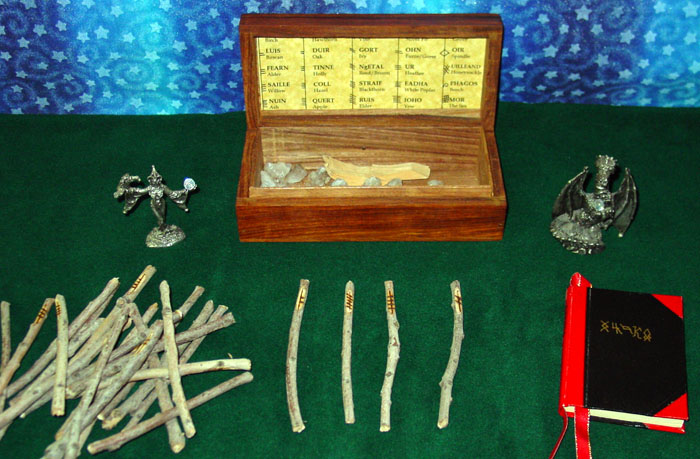

Introduction to the Ogham Oracle
The human mind never seems to be satisfied with itself. It is an innate function of consciousness to always reach beyond itself, into the unknown. Indeed, if certain theories of consciousness are correct, this reaching into the unknown is what consciousness is all about: consciousness always seeks to expand itself by embracing new knowledge, by making the unknown the known, and the fantastic the familiar. While the experimental sciences systematically add to the knowledge that can be discovered through the senses, the theoretical sciences, along with philosophy and its related disciplines, strive to expand the limits of what can be known through reason, and the arts probe the frontiers of passion and imagination, there are limits to what these disciplines, by themselves, can reveal. Consciousness demands to go further, to go beyond what can be discovered through the senses and reason alone. It seeks that which lies beyond time and space, that which lies hidden in the past and beyond the veil of the future, and even that which lies deep within its own core -- the mysterious Self, and the source from which that Self came. Here, science and philosophy -- or at least the materialist versions of these disciplines -- become useless as revealers of hidden knowledge: consumed in their own deflationary ideologies, they deny the existence of the very things consciousness seeks. But there are other kinds of science and other kinds of philosophy, and it is to these we must turn if we seek to know the mysteries of what lies beyond the physical world.
The process of discovering this hidden knowledge is called "divination," variously defined as "finding the will of the gods," "seeing with the mind's eye," or simply, "finding things out." It implies something more than a laboratory experiment or a logical proof: it is a participatory phenomenon, one in which the mind of the seer learns through union with, as opposed to objective detachment from, the thing which is known. Of course the "objective" viewpoint from which scientists and philosophers approach their subjects has been impugned -- if not formally impaled -- from the scientific side by quantum uncertainty and from the philosophical side by perspectivism and critical theory, but nonetheless the fantasy lives on. From relativity theory and quantum mechanics we have learned that time, space, and causality are not absolute qualities, but are relative quantities, that include the observer in their characteristics. Unfortunately, as Kuhn wrote, for a major scientific paradigm shift such as this to occur, science must wait for those who maintain the old views to pass away and their positions in the scientific community fall into the hands of those who embrace the new views -- who then become those who hold the old views, and so on. Fortunately for those of us who refuse to be bound by the restraints of the academic atheocracy, there is an alternative.
It was not always true that science and philosophy were at odds with metaphysics and spirituality. (Yes, I am aware that modern philosophy considers metaphysics one of its branches, but what passes for "metaphysics" in modern philosophy has nothing to do with the traditional understanding of the term.) In spite of materialism and its associated ideologies, the theoretical sciences have stumbled upon what was once ancient knowledge. Ideas like uncertainty and chaos theory have prompted some to describe the universe as "participatory", meaning that the universe we see is as much a product of our own activities as of other entities and energies. This is, in reality, the reappearance of an ancient idea -- what Levy-Bruhl called participation mystique, the idea that the individual is a participant in the events of the universe, just as the universe is a participant in each individual life. Participation lies at the foundation of ancient and modern pagan spiritual belief systems, magic, and most importantly here, divination. To those who hold a participatory world view, it is possible, through a fusion of observation, reason, inspiration and imagination, to produce a system of abstract representations, or symbols, that tap those sources of energy that are not directly accessible to consciousness. Such a symbolic system is an oracle, essentially a roadmap of the unconscious, through which both natural and superconscious energies can become known to consciousness. To access the oracle, one most often uses a set of physical symbols that correspond to the unconscious pathways of the oracle. Through practice, one is able to use these physical symbols to forge the mental connection between conscious and unconscious, and thereby "see" the unconscious factors that bear upon a particular situation.
This is not all a strange as it may seem. It may seem impossible to the city dweller that professional and native guides are able to find their way through dense forests and mountain ranges without a roadmap. Such a feat is possible because the guides are attuned to the subtle characteristics of the forest and mountains that are as obvious to them as a street sign is to an urbanite. To the urbanite, it is "impossible" only because he has no idea how to do it, nor any experience with it, nor any understanding of what information is contained within the arrangements of trees and hilltops. So is the case with the diviner. It seems "impossible" that it even could be done, but it only seems so because of ignorance, inexperience, and most importantly, a closed-mindedness encouraged by a materialistic culture, and what has come to pass for "philosophy" and "metaphysics" in that culture. The ability to traverse the unconscious is really no more "mysterious" than the ability of the mountain man to find his way through the woods.
Probably the best known divinatory system is the Tarot, a set of cards bearing mysterious pictures and an even more mysterious ambience, due in no small part to the secret societies and flamboyant individuals who adopted it. Even today, with hundreds of Tarot decks and books on the subject readily available, there remains an aura of mystery and strangeness to it. This is because the oracle of the Tarot -- the metaphysical system to which the cards give access -- is itself abstract and mysterious. The occult societies that flourished near the end of the nineteenth century -- interestingly enough, at the same time the groundwork for relativity theory was being established -- assigned the symbols of the Tarot to aspects of the Cabala, a metaphysical system originating in ancient Hebrew philosophy, but later modified by occultists as a vehicle for their secret teachings and rituals. In addition to the Cabala, more recent Tarot authors have assigned the symbols of the cards to metaphysical systems including Celtic, Greek, and Egyptian mysteries, and even to the dark pantheon of H. P. Lovecraft.
The trouble with all of these systems is that while they are well attuned to the superconscious energies that Jung identified as archetypes, they do not effectively represent the more subtle energies of nature that, like the archetypes, lie outside the range of conscious perception. Abstract metaphysical systems in general have as their purpose the expansion of human consciousness to the realm of the spiritual, but along with that focus comes a relative insensitivity to the intangible natural energies that play just as much a part in human consciousness as the superconscious archetypes. It is these energies of nature -- the passing of the days and of the seasons, the power of the thunderstorm and the blanketing of the Earth with snow, the majesty of the mountains and the mysteries of the deep seas -- that first drew human consciousness out of its insect-like mental precursors, and laid the psychic foundation for the connection with superconscious spirit.
I like to compare human consciousness to the growth of a tree. At the bottom are the roots, through which water and nutrients are absorbed. In the trunk are the genetically controlled mechanism for transporting nutrients and fluids up and down the tree. At the top, the leaves emerge, and once bathed in sunlight, develop into a twisted pattern of branches that is unique to every tree. Even if you make genetically identical cuttings of a tree, each individual will be unique -- its pattern of leaves and branches is determined not by DNA, but by the influence of the sun upon each individual plant. Now in the human brain, the "old brain," or limbic-brainstem system, is much like the trunk of a tree -- its structure is by and large genetically determined, and it is responsible for the basic physiological functions of the body. The "new brain", or thalamo-cortical system, develops largely without any information structure. Like the branches of a tree, it takes on its ability to think as a result of exposure to its environment. The complex interconnections of the cerebral cortex develop, like the branches of a tree, in response to things that go on around it. By analogy, human consciousness has its roots in the Earth -- in the subtle energies of nature that first brought about participation mystique. That consciousness takes on individual form when it is illuminated from above by the superconscious or "spiritual" energies; consciousness becomes an individual when it receives both the natural and spiritual energies from the world around it.
So the Tarot, for all its virtues, is really an incomplete oracle, as far as understanding all of the forces that shape the world and consciousness itself. Being attached to various esoteric systems, it loses direct contact with the natural forces of participation, and thereby misses quite a bit of the unconscious. This problem becomes much more serious when added to the fact that modern urban culture isolates the individual from those very natural forces that first produced consciousness. Gone are the passing seasons, blotted out by "controlled environments." I have said more about this in Spontaneous Human Consciousness; it is enough to mention here that the more esoteric oracles miss these forces completely. There have been some attempts by Tarot authors to create a system that does reflect these participatory energies, but as of yet none has been able to adequately reflect both the natural and the spiritual aspects of the unconscious.
I don't mean to say the Tarot is junk; it isn't, and I use it myself. I am merely pointing out one of its limitations. Until someone devises an oracle that encompasses everything from nature to mind to spirit, we will need a different oracle to capture the subtle energies of nature, and how those forces interact with mind and spirit. There are reasons to believe that such a "complete" oracle is impossible. Those reasons are connected with the Incompleteness Principle, which involves the basic structure of the universe itself. This is not something to bemoan, but rather something to rejoice in -- it means no one will ever know everything, and that deflationary theories like mechanism and determinism can never be true. There will always be new things to discover, and there will always be individual and unique consciousness to discover them. The impossibility of omniscience guarantees psychic freedom.
It is no coincidence that I picked the tree as the model for human consciousness, for the ancients discovered that trees -- like human consciousness -- are powerful conduits of energy from the earth to spirit, and visa versa. Energy is always in motion; when it becomes stagnant, those things that are enlivened by it become stagnant and decay. Just like consciousness, trees move the energies between the polarities of earth and spirit, and just like human consciousness, what makes each an individual is what it does with those energies along the way. What the ancients discovered is that different trees move those energies according to different patterns, and through a combination of observation and imagination, a general pattern can be described for each kind of tree. Those patterns became known, among the Druids, as the Ogham oracle.
The symbolic system associated with the oracle is Ogham writing, a pattern of scratches that could easily be made on wood or stone, with each symbol corresponding to a particular species of tree. Ogham writing came to be associated with sounds , and eventually took on the role of a written alphabet. But their underlying purpose remains as oracular symbols, for purposes of divination and magic. Like the symbols of the Tarot, they connect the mind of the diviner with the oracle of the trees, and create the participatory link between the seer and unconscious energy.
There are some major differences between the Ogham and the Tarot. As already mentioned, the Tarot relies upon abstract oracles for its interpretation, and as such, the mind of the diviner plays a major role in the meanings read into the cards. This gives that Tarot an analytical dimension that other oracles do not have, but it also makes the Tarot highly susceptible to misreadings and misinterpretations (or maybe more accurately, disinterpretations), depending upon what the diviner wants to see. The strong mental component to the Tarot often results in the cards merely reflecting the mind of the diviner, or questioner, or both. Under certain conditions, that can be useful, but more often than not it results in a reading that is nothing but psychobabble and touchy-feely chattering.
The Ogham is more closely connected with natural forces and situations, and as such is relatively insensitive to the mental state of the diviner. Far more important to this oracle are the time of year and day, phase of the moon, place where the reading is done, the direction one is facing while doing the reading, and even to some extent the weather. These considerations are minimally important with the Tarot, but they are absolutely crucial in the use of the Ogham. You can imagine yourself in a grove of oaks or in a temple, and this will work almost as well as being there with the Tarot, but not so with the Ogham. The Ogham symbols align themselves according to natural forces much as a compass needle aligns itself with the earth's magnetic field, and if those forces are distorted or inappropriately aligned, readings will not be accurate. Attempting a divination in matters pertaining to Brigid at Samhain, for example, is bound to produce erroneous results with the Ogham. The other side of this coin is that the Ogham, like the rune stones, tends to wear its meaning in your face, so to speak. While one can usually twist the Tarot to mean whatever one wants, the Ogham is relatively immune to this kind of mental trick, and unless great mental determination (meaning, outright lying) is applied, the Ogham will speak what it will. The Ogham is down-and-dirty shamanistic divination -- the Celtic equivalent of "the bones" -- and is more suited to those who are ready to face reality with the courage to accept it and, where necessary, the will to change it, than those who are looking for self-abuse or self-aggrandizement.

The most traditional version of the Ogham used for divination is the Ogham sticks. These are small sticks of wood, with the specific symbol either engraved, drawn, or burned into the wood itself. Some diviners believe the sticks should be made from oak, the tree of wisdom. Others prefer yew, the gateway between this and the Otherworld. Some argue that each stick should be made from the particular tree it represents. Sticks made according to this last method might make the strongest conscious-unconscious association, but not everyone has access to each required tree. While I would have preferred yew, there are none where I live, so mine are made from oak, which is readily available. I cut them about five inches long, shaved a flat spot near the end, and marked each stick using a wood burner. For those who just want to experiment, a set of Ogham sticks could easily be made from ice cream sticks. Here again, there is some disagreement among authors as to how the sticks should be prepared. Some would say they should be cut at high noon while invoking the wisdom of the Sun; others argue for cutting and preparing the sticks during the dark moon, as a gateway to unknown secrets. You must follow your own wisdom in these matters.
More recently, there have appeared several Ogham card decks, in addition to at least one set of pre-made sticks. Some of these card sets simply show the Ogham symbol, while others are illustrated with the tree represented by the symbol, or with symbolic pictures as in the Tarot, or some combination of these. There is some divergence of opinion among authors as to how many Ogham symbols are used for divination; the numbers range from about 15 to 25. In addition, different authors, based upon their own research and insights, assign different trees to the Ogham symbols. The Ogham is a very old system, and the ancient writings and lore associated with it often produce different interpretations among the various authors. In practice, this does not present a significant obstacle. You learn with one particular version of the Ogham; most diviners who use this method eventually make their own Ogham sticks or other devices, so in the long run you should consider the opinion of the author who created the book and/or Ogham you use to be a guide, that will eventually be supplanted by your own insight and experience.
Just as authors diverge in the number and meaning of the symbols, there is also divergence as to how the oracle should be consulted. Not surprisingly, given the popularity of "psychological" interpretations of the Tarot, many have suggested similar interpretations for the Ogham. I do not believe the Ogham, or any other oracle, exists for the purposes of self-criticism or meddling in personal and "interpersonal" business, and in my experience, the Ogham tend to react rather unpleasantly to such foolishness. The oracle of the Ogham is completely different from that of the Tarot, and the energies the Ogham evokes have a ruggedness and a cosmic vastness that preclude mental manipulation by the reader. My suggestion would be that once one learns the lore of each tree symbol, one should spend some time in ritual concentration with each symbol, learning what the energies of each tree symbol bring forth within one's own consciousness. If your understanding of the symbols winds up differing with that of the particular author you are reading, fear not -- it is your consciousness, and not someone else's, upon which you must rely to extract meaning from the symbols. Be guided by the lore and what it inspires within you, for this is the only true wisdom you can ever know.
How does one actually consult the Ogham? As I said, things that make little or no difference in reading the Tarot may be very important in using the Ogham. The oracle is best consulted outdoors, in the presence of the trees from which it is derived. Other things that are important are the time of year, time of day, and direction one is facing. The oracle tends to speak most freely at the traditional festival times: Imbolc (Feb 1), Beltane (May 1), Lughnasad (Aug 1), and Samhain (Nov 1). I prefer to face north, the traditional direction for the Stone of Destiny, but you might want to consider other directions if you are consulting for a specific question. I also read at night, under the light of a fire; but you can do this inside your house, under the light of a candle, if this is what your circumstances dictate. Other ritual preparations are to be made according to your own tradition and preferences.

Those who use Ogham cards tend to rely upon Tarot-like layouts or spreads, with each position having a particular significance. Some even use the same layouts as for Tarot cards, although as I have warned, be prepared for a very different energy dynamic. Likewise, some who use the sticks have layouts with specific meanings attached to specific positions. In my case, I prefer to "shuffle" the sticks by rolling them around in may hands, and then throw the whole mess on the floor like pickup sticks. I take note of those sticks whose symbols are exposed for me to read, and interpret the symbol according to which direction it is pointing: Air in the east, Fire in the south, Water in the west, and Earth in the north. Finally, I note the position in the "pile" of each of these visible sticks -- those on top are the more visible and straightforward energies acting in the present, while those near the bottom are hidden influences that may reside in the past or future. I seldom consult with a specific question in mind; I let the top sticks inform me as to the matter being revealed.
The short reviews that follow present some of the Ogham products available, both as cards and as sticks, along with books that provide additional background information. There are other products and books available; these are the ones I have used, and found helpful.
Review: The Celtic Tree Oracle, by Liz And Colin Murray, pub. Thomas Dunne/St. Martin's Press, 1988.
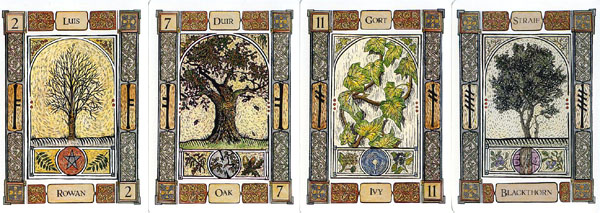
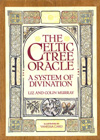
This high-quality oracle set consists of a deck of cards, a hardback book, a notepad and a layout sheet, all packaged in a wooden box. The cards, of which there are 25, are a little smaller than the usual Tarot cards, measuring 6.6cm X 9.5cm, and are printed on stock that is relatively thick and inflexible. For this reason, I would suggest hand-over-hand shuffling as opposed to riffle shuffling; with only 25 cards, this method should give adequate results without bending or damaging the cards. The backs of the cards are dark green, with a golden knotwork design. The fronts are beautifully illustrated with a thin outer white border, and a thicker inner border of knotwork design, at the top of which is the name of the Ogham written out, and for those Ogham that correspond to one of the Celtic lunar months, the number of the relevant month. The Ogham symbol itself appears along each side, and at the bottom is the modern English name of the tree. The center of the card is illustrated with the tree itself, along with its rank -- in some systems, trees are accorded different ranks, which figure in their importance in a reading.
The book is about 120 pages, and is good quality. The inner covers each have a short guide to the Ogham, which is very handy for jogging your memory. The text itself begins with a short introduction to the Ogham -- their origins, letter correspondences, and relationship to other forms of divination. The main text is a card-by-card exposition of the lore, and suggested upright and reversed meanings. Following this, there is a section on reading the cards, which describes a somewhat complicated layout, for which a notepad and layout sheet are included in the set. Several case histories using this method are presented, along with some additional notes on the Celtic calendar. The set is very complete, is artistically artistically attractive, and does not assume that you know anything about the subject in order to get started.
I would recommend this set for anyone who wants to develop a general knowledge of Ogham lore, and who wants to give the oracle a try without the investment of time and energy in making a set of sticks. In fact, I would say that to make a set of sticks, one should have a certain familiarity with the energy of the Ogham before creating a set of sticks in the first place. I do not find the recommended reading method useful for the way I read, but I imagine it would be a good place to start. There is a tendency to want to use Tarot type layouts for the cards, but this is not recommended because the Ogham is not the Tarot, and Tarot layouts do not, at least in my experience, give useful results. Probably because of the packaging and the neatness of the set, when the box is opened there is something of a feeling that one is opening a Jumanji game; I suppose in the hands of an experienced Oghamist -- or an utter fool -- that might just be true.
Review: The Celtic Oracle, by Nigel Pennick and Nigel Jackson, pub. Aquarian/Thorsons, 1991 (OP).
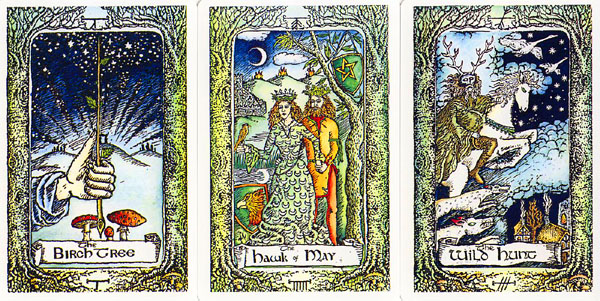
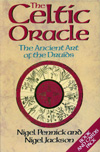
I would not ordinarily review an out of print product; it seems a useless thing to do, if you can't get it. But I have done so here for two reasons. First, you may yet find copies available on the internet, and second, the lore presented in this set is still available (see New Celtic Oracle, below).
This is a cards and book set, but what makes it different from The Celtic Tree Oracle above is that the focus of the cards is on interpretive illustrations more like the Tarot, rather than just a straightforward depiction of the Ogham and its associated tree. The interpretations in this set add an entirely new and dynamic dimension to the Oghams. The Birch Tree, for example, shows the hallucinogenic mushrooms often associated with it, which adds a much richer set of associations to the traditional meaning. Reed (NgETAL) becomes The Wild Hunt, while OHN becomes The Queen of the East. The lore and divinatory implications for each of these cards is explained in the text, and I cannot overemphasize the degree to which this additional lore broadens the understanding of the oracle. There are, of course, the usual introductory information and suggested layouts for the cards.
The richness that this symbolism adds to the oracle even prompted me to do the Thing That Must Not Be Done -- to try to establish correspondences between the Ogham and the Tarot, and especially the Major Arcana. Don't waste your time and mental energy on that project. The oracle of the Ogham is completely different from that of the Tarot, and one cannot draw comparisons between the two without falsifying the meaning of one symbol set or the other. Instead, regard the Ogham as a different way of looking at things, and in some cases, a look at different things than what the Tarot sees. The Ogham often looks upward from the standpoint of the Earth, whereas the Tarot very often looks downward from the standpoint of superconsciousness. What I do suggest that you do is to obtain a small notebook with bound pages, something like the usual lab report or composition book. You will, for the Ogham, want somewhere around 100 pages. You can assign, say, two pages to each symbol, with additional pages in the front and the back for your own notes and your own layouts. Then, for each symbol, add to its pages notes on the lore as you collect it. Sooner or later, you will want to develop your own interpretations based on this collected information. You can then conveniently refer to this information, which is handy to have when the cards (or sticks) seem to be speaking gibberish, a situation that is not unusual, even for experienced readers.
Review: New Celtic Oracle, by Nigel Jackson and Nigel Pennick, pub. Capall Bann Publishing, 1997.
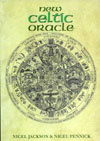
Although the Celtic Oracle set described above is out of print, you can obtain an expanded version of the book by the same authors. This is one of the best guides to interpreting the Ogham. It is not enough to simply learn keywords to interpret an oracle; whether it is the Tarot, the Ogham, or anything else, the more you know of the history and the mythology connected with it, the better you will be able to understand what the symbols are trying to tell you. Knowing the lore means you can use the symbols to weave a "story" out of the reading, and this is a much more effective way of using the oracle than simply blurting out disconnected keywords. There is quite a bit more information in this book than in the original, and it will greatly enhance your understanding of the Ogham.
Review: Celtic Wisdom Sticks, by Caitlin Matthews, pub. Connections Book Publishing, 2001.

In the old days, we had to go out in the groves and cut our own... It's still a good exercise, but for those who want an introduction to this method of divination, the Celtic Wisdom Sticks by Caitlin Matthews are ideal. The kit consists of an instruction book, a set of Ogham sticks, and a bag in which to keep them. There are 20 triangular shaped, pointed sticks, each having the name and letter of the Ogham written on it, plus the Ogham itself burned into the stick with a wood burner. An additional four-sided "direction" stick is included, with each side bearing one of the less traditional diphthong Oghams. This stick is used to indicate a direction -- north, south, east or west -- which modifies the meaning of the traditional sticks. Several different layouts for reading the sticks are included in the book, as well as descriptions of the trees represented by the Ogham, the lore connected with those trees, and the meaning of the Ogham as modified by the direction stick.
In a brief note on the publication data page, the author states that, "The Ogam oracle of the Celtic Wisdom Sticks has been conceived through a fusion of textual research, poetic insight and shamanic analepsis or far-remembering by which the Irish filid (poets) used to discover lost or forgotten information." This is a very important point to keep in mind when dealing with the Ogham, or any other oracle for that matter. There are no texts capable of telling you exactly what each symbol means. There is the lore, or the history, mythology, and "stories" connected with each symbol; there are your own impressions about what the symbol signifies; but to round out the understanding of the symbol, there must be a mental connection between your own consciousness and the collective unconscious with which the symbol resonates. Without this connection, one is simply reading fortune cookies, and not interpreting the oracle.
As is true of most commercially available oracle products, I find many of the interpretations given in the book leaning too far toward personal advice and "positive thinking" psychology -- which generally turns out to mean self-criticizing and other-aggrandizing -- as opposed to the more metaphysical interpretations I prefer. This set is not as bad as some in that respect, but even so, it should not be a deterrent to trying this excellent product. It will give you the full flavor of the oracle, using the ancient methods for reading it.

Review: Tree Wisdom -- The Definitive Guidebook, by Jacqueline Memory Paterson, pub. Thorsons, 1996.
This truly is the definitive guidebook to the lore of the trees. After a brief introduction, each of 17 trees has its own chapter, containing a Botanical description, Custom and Legends, Healing uses, Magic, Inspiration, and Physical Uses. Following this is additional information, including divinatory uses and the Ogham oracle. The wealth of information in this book will take your understanding of the Ogham well beyond that of divination, which, in turn, provides a much richer reservoir of lore from which to draw divinatory interpretations. The only complaint against this book is that the illustrations are rather sketchy black-and-white drawings, that do little to enhance your visual imagination of the tree itself. This problem is easily remedied with...
Review: The Wisdom of Trees, by Jane Gifford, pub. Godsfield/Sterling, 2000.
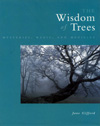
Like the above book, this work contains a wealth of information on the lore and uses of the trees. Each tree has its own chapter that describes the tree and its lore, its Ogham symbol, mystical associations, healing properties, "lessons", and divinatory implications. But its most appealing quality is the photography. Each tree or plant is photographed in its natural setting, in many cases including closeups of flowers, fruits, and leaves. These are not your usual guidebook pictures; each photograph is carefully composed to relate not only the physical image, but the energies that go along with it. If you have never seen the trees mentioned in the Ogham, or do not have access to them, this is the next best thing to being there. These photographs turn the abstract symbolism of the Ogham into a living presence, along with enlivening the symbol with the energy of the tree and its surroundings.
Review: The Celtic Seer's Sourcebook, ed. John Matthews, pub. Blandford, 1999.
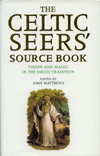
Subtitled, "Vision and Magic in the Druid Tradition," this book is a compendium of essays by scholars and others that carefully examine the magical side of ancient Celtic teachings, with emphasis on visions, the Ogham, and prophecy. For those who want a deeper understanding of these matters than is available in the popular literature, this is the source to use. You will find material here that can only be found through extensive research, if at all. There is a strong emphasis on the oral tradition among the Druids, as well as on nature mysticism and its uses in divination. This is a solid reference work for those who practice in the Celtic tradition.
Review: Circles of Stone, by Max Milligan and Aubrey Burl, pub. Harvill, 1999.
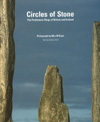
This book does for the ancient stone circles what Gifford's book does for the trees. No one knows exactly who built the ancient monuments, or why, or what their relationship was to later Druidic practice. But we do know that many who practice in the Celtic tradition, Druidic or otherwise, feel a strong sense of participation with the ancient circles of stone. While some of the ancient circles were large and spectacular, others are smaller and charming, but nonetheless beautiful. All of them honor an ancient power that the materialism of this culture cannot fathom, and perhaps out of fear cannot acknowledge. While not directly related to the Ogham itself, I include this book here because it is the best photographic presentation of these mysterious structures, and those who wish to practice with the Ogham may find it useful for active imagination and visualization.